| June 2000 Film Music CD Reviews | Film Music Editor: Ian
Lace Music Webmaster Len Mullenger |
|
index
page/monthly
listings/May/
 For
those wishing to print these reviews without CD cover graphics
there are scrolling copies available
For
those wishing to print these reviews without CD cover graphics
there are scrolling copies available
Month by Month
index Alphabetical composer
index
© Film Music on the Web 2000.
All rights retained.Reviewers retain copyright on their
reviews.
Return to the June Index with thumbnails Part 3 [Part 1] [ Part 2] [ Part 3 ]
CDs may be purchased from the retailers listed at the bottom of the page with a saving of around 22% Donations Disclaimer
Nino ROTA
Chamber Music
Ex Novo Ensemble
ASV CD DCA 1072 [72:40]
Purchase from: Crotchet
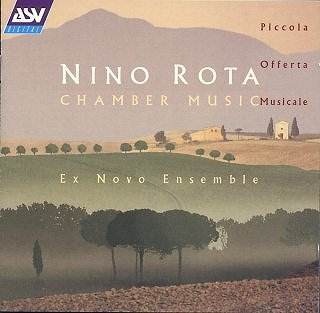
Nino Rota has for decades been tarred with the same lazy brush used to paint Erich Wolfgang Korngold into the musical background of the 20th Century. Both were child prodigies, Korngold premiering an opera at 12, Rota conducting his oratorio The Childhood of John the Baptist at 11, and both had the unthinkable temerity to be successful film composers. Snobbery and prejudice runs as deep in the classical music world as anywhere, so it is heartening that following the rehabilitation of Korngold, Rota is finally being recognised as a worthwhile composer. A disc of two piano concertos has recently been released, while this current programme collects 6 chamber works.
Rota was born in 1911, his home city was Milan, and wrote 150 'serious works', and as many film scores. His music has a light, clean elegance in which can be seen the influence of Debussy and Ravel, as well as the later group of French composers known as Les Six (particularly Auric, Poulenc and Tailleferre) who were operative in the 20's when Rota would have been particularly open to musical influence.
The Sonata for flute and Harp (1937) is playful and utterly beguiling. To say that it is typical of tonal chamber music of the period is not to do it a disservice, and the performances have a pleasingly airy touch. The works are not sequenced in order, and the opening piece from 1937 leads to the Trio for clarinet, cello and piano from 1973, the Allegro festoso which ends the first work deliberately echoed in the opening Allegro of the second. The Allegrissimo which ends the trio has a playful wit which must have seemed very out of time to the critical fascists of 1973, always so keen to dictate what music should sound like, a finale very much replete with a skittish humour that refers back to Poulenc. Still, Rota had survived one lot of fascists in his native land (in 1933 he wrote he first film score for the fascist film The People's Train), and clearly he had no intention of allowing a musical version of the same mentality to govern his compositional life.
It could be argued that the String Quartet (1948) is a neo-classical work - Rota was friends with Stravinsky after all. It certainly has that sort of clear elegance, and a happy lack of tortured romantic questing, yet there is a nostalgic yearning in the opening them which is more warm-hearted than the neo-classical school usually offered, and rather seems to prefigure some of Bernard Herrmann's chamber music, specifically, the lovely Clarinet quintet - Souvenirs de Voyage (1967). The Quintet for flute, oboe, viola, cello and harp (1935) is the sort of beautiful, descriptive pastoral work which might be taken for something out of the line of Vaughan-Williams or Bax, except that there is also a clearly Italianate line of sunny romance with one eye on the distance past that would reappear in one of Rota's most famous film scores, Romeo and Juliet (1968). It is a lovely work at which cynics will delight in sneering, but has an innocent freshness of a perfect summer's day in the country. The adagio has a folksong-like tranquil melancholy, a gorgeous melodic sense just right for Shakespeare's star-crossed lovers. Indeed, two years later, Rota's thesis studied the 16th century Venetian composer and theorist Gioseffo Zarlino, while Rota's first regular music teacher was Pizzetti, whose 'Pizettian counterpoint' was inspired by the Italian Renaissance.
The Trio for flute, violin and piano (1958) has an urgent propulsive drive in the opening which soon surrenders to a more languid atmosphere, the ideas alternating like a dance, a flirtation, a courtship, perhaps a three way argument in which no one really falls out and everything is amicable resolved in the genial finale. The disc ends with the short Piccola Offerta Musicale for wind quintet (1943). This is a single movement running 3:43 in this performance full of vivacious charm and jokes.
The playing by the members of Ex Nono Ensemble seems utterly in sympathy with this music, simply enjoying the pleasure it brings while delivering rounded and accomplished performances. The sound meanwhile, is clear and natural, with an appropriately airy acoustic.
Rota once said, "I'd do everything I could to give everyone a moment of happiness That's what's at the heart of my music." Perhaps why other, less happy, more neurotic, critics have for so long dismissed him. "They reckon my music's just a bit of nostalgia, plus lots of good humour and optimism? Well, that's exactly how I'd like to be remembered…"
And perhaps we will, long after the tiresome sniping has been forgotten. A very lovely album indeed.
Reviewer
Gary S. Dalkin

Collection: FilmFour Essential Soundtracks: The Classical Collection.
Telstar TV/FilmFour TTVCD3082 2 CD [98:58]
Purchase from: Amazon UK Amazon USA
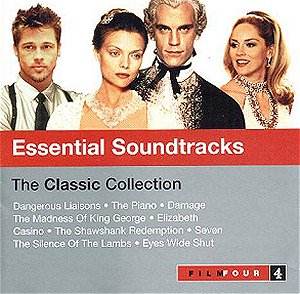
FilmFour broadcast here in the UK on terrestrial as well as satellite TV, is doing a magnificent job not only screening interesting and unusual films from around the world but also helping to produce new films. This double album is a reflection of the its high standards; it contains an imaginative and intelligent collection of selections that are a mix of classical source music and excerpts from the original recordings of original scores.
The classical selections are by top artists delivering often top-recommendation performances. There is Luciano Pavorotti singing "Che gelida manin" from La Bohème as used in A Midsummer Night’s Dream; Handel’s Zadok the Priest used in The Madness of King George and; Solti’s reading of Bach’s St Matthew Passion Chorale as heard in Casino. There is the elegant Bach Concerto in A minor for four Harpsichords that counterbalanced so well the vicious amorous intrigues of Dangerous Liaisons; and Mozart’s "Duettino – Sull’ Aria" from The Marriage of Figaro as recorded by Karl Böhm and used in The Shawshank Redemption. Polished playing by the Grimethorpe Colliery Band of Rodrigo’s Aranjuez music is heard as used in that marvellous comedy Brassed Off.
Amongst the many original scores there is: David Hirschfelder’s darkly dramatic Elizabeth Overture full of foreboding; Michael Nyman’s themes for The Piano and The Draughtsman’s Contract; and Howard Shore’s intense music, again shadowy and portentous, for The Silence of the Lambs; and Trevor Jones’s memorably exciting Main Title music for The Last of the Mohicans with its Indian-inflected rhythms and those persistent war drums. Gabriel Yared’s haunting theme music for The English Patient is included forever to be associated with that opening shot of the stricken plane flying across the desert. Music form Ennio Morricone’s Once Upon A Time in America and Cinema Paradiso is included, so too is the Prelude and Rooftop music from Bernard Herrmann’s Vertigo.
A well-above-the-average compilation; recommended.
Reviewer
Ian Lace

Curio Corner
Regular Feature: If Only They Had Written for Films:
No. 3: Sergey RACHMANINOV (1873-1943)
Rachmaninov died only ten years or so after the establishment of modern original scores at the beginning of the ‘talkies’ era. His music has been used in several films, notably his Piano Concerto No. 2 in C minor in Brief Encounter, and the famous Variation No. 18 of his Rhapsody on a Theme of Paganini in The Story of Three Loves. His Piano Concerto No. 3 was played and was featured extensively in Shine, the film based on the life of pianist David Helfgott. Interestingly, at the same time as the early scores by Max Steiner and Korngold etc., there was a late flowering in Rachmaninov’s composing career: the Rhapsody on a Theme by Paganini (1934), the Symphony No. 3 in A minor (1936), and Symphonic Dances (1940). But Rachmaninov was very much occupied with his concert platform career as one of the most accomplished pianists ever and so the chances of him composing for the screen were slim indeed. Nevertheless his compositions are the stuff of film music: heroic, sadly sentimental, romantic and yearning; colourful and atmospheric -- and supremely melodic
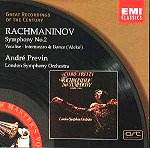 |
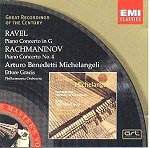 |
|
Besides the immensely popular Piano Concerto No. 2, the following works are recommended, they are representative of different genres.
Rachmaninov’s Symphony No. 2 brims with good tunes; it is exciting with one of the composer’s most appealing broad romantic melodies gracing the slow movement. The recommended recording is by André Previn recently reissued in EMI’s Great Recordings of the Century series. Another remarkable reissue in this admirable series is the brilliant performance by Michelangeli of Rachmaninov’s greatly undervalued and less immediately accessible, but nonetheless rewarding Piano Concerto No. 4 (coupled with Ravel’s Piano Concerto in G Major). The more immediately appealing Piano Concerto No. 3 is played by Martha Argerich who attacks Rachmaninov’s passionate music like a tigress in the Philips (446 673-2) top recommendation which also includes a hair-raising account of Tchaikovsky’s very popular Piano Concerto No. 1.
Rachmaninov’s symphonic poem, The Isle of the Dead could have been written for a screenplay. The evocative opening music of a boat, carrying the coffin, gliding through the mist towards the mysterious island of Böcklin’s gloomy painting is very potent and the turbulent central music recalling the dead one’s tumultuous life is also remarkably compelling. The recommended recording is by Ashkenazy, and it is coupled with Rachmaninov’s tremendously exciting Symphonic Dances on Decca. As a sample of Rachmaninov’s instrumental writing for piano, why not try the new, highly esteemed BIS recording of the Piano Sonata No 2 and the Études-tableaux Op. 39 played by Freddy Kempf?
Finally Rachmaninov’s sublime and very melodic a cappella choral music of his Vespers (or All-Night-Vigils) should not be missed. Here the recommended recording is by The Saint Petersburg Cappella on Saisson Russe (harmonia mundi) RUS 788050.
Incidentally, five of Rachmaninov’s Études-tableaux were orchestrated by the Italian composer, Ottorino Respighi. Respighi will be the subject of next month’s edition of ‘If Only They Had Written for Films.’
Victor HERBERT (1859-1924)
Columbus Suite. Irish Rhapsody. Auditorium Festival March. Selections from Natoma
Keith Brion conducting the Slovak Radio Symphony Orchestra (Bratislava)
MARCO POLO 8.225109 [67:13]
Purchase from: Crotchet

Dublin born, Victor Herbert receive his musical training in Germany and went to the U.S.A. when he was 27 to play at the Metropolitan Opera. He was prodigiously multi-talented: a major orchestral conductor (Pittsburgh Symphony Orchestra), orchestral, opera and (silent) film composer, presenter of pops concerts, a fabulously successful bandmaster (competing with Sousa) and a leading composer of Broadway musicals including Naughty Marietta and Babes in Toyland both of which were subsequently filmed. On top of all this he was, for a time, America’s premiere solo cellist
This second concert of Herbert’s music, released by Marco Polo, is conducted by Keith Brion who is director of his own Victor Herbert Orchestra and New Sousa Band. He is known internationally for his specialisation in the works of Victor Herbert, John Philip Sousa, Percy Grainger, Alan Hovhaness and Charles Ives.
The present concert opens with Victor Herbert’s Auditorium Festival March created for the Pittsburgh Symphony Orchestra and celebrating Chicago’s Auditorium Theatre where Herbert had ambitions to take his Pittsburgh orchestra. This was the piece that helped clinch the deal. Its jubilant imposing opening will lift you from your seat. Contrasted with the ceremonial pomp are more tender waltz passages and the incorporation of Auld Lang Syne.
Brion proceeds to a scintillating performance of Victor Herbert’s Irish Rhapsody. With harp prominent, misty nostalgia is an early ingredient but the appellation of one commentator, ‘The Irish Wagner’ is appropriate here as we have grand noble material alternating with sweetly sentimental treatments of: All Those Endearing Young Charms; To Sadie’s Eyes; Come O’er the Sea and Rich and Rare Were the Gems She Wore; while the work ends with a rousing brass rendering of Erin Oh, Erin.
A real find is the music for Natoma one of only two grand operas written by Victor Herbert. Herbert composed it working from fragments of Indian music which, to avoid monotony, he harmonised in his own way, while still retaining something of the Indian character. The selections here include mistily atmospheric passages, tender material and war dance music. At least one of the big romantic themes uncannily anticipates Max Steiner. There is also considerable use of exotic Spanish dance rhythms – presumably to suggest the Conquistadores? Why mention of this wonderful music has been omitted from the front cover of the CD booklet, I cannot imagine -- for me it is the best work on this disc.
The major work in the concert is the four-movement, 28-minute Columbus Suite. It begins with the impressionistic ‘Dawn and Sunrise’ which is representational of the great Moorish castle of Ferdinand and Isabella illuminated in an increasingly brightening dawn light until the huge redoubt is revealed in all its magnificence. This is a leisurely portrait, slow to build up to its shattering climax. A piece that brings Wagner face to face with Debussy. ‘At the Convent’ is a shorter but more complex movement with ceremonial pomp, quiet introspective organ prayers and music which signals dread anticipation of the hazardous voyage ahead. ‘Murmurs at Sea’ must be one of the most placid musical seascapes ever. All is calm, the sea glassy, just the quiet gurgling of waters brushing against the keel and soft breezes murmuring in the rigging. Occasionally, a sea bird flies by. Distant thunder is heard which comes little closer then passes. The final movement ‘The Triumph of Columbus’ expands on this mood then the lower strings evoke swelling seas, eventually rising to become powerfully surging as the music reaches a triumphant conclusion.
Heartily recommended
Reviewer
Ian Lace

Rob Barnett adds:
Herbert is known for his numerous contributions to early American musical theatre. Marco Polo now remind us of his work in the classical concert hall in the 1890s when he was director of music with the Pittsburgh Symphony. Marco Polo are not the first to do this. Karl Krueger's Society for the Promotion of the American Musical Heritage recorded Herbert's tone poem Hero and Leander back in the 1960s but since then nothing.
The regal and sumptuous march suffers from a bit of middle age spread and is slightly cheesy in its use of Auld Lang Syne but offsets this with its conviction, sharp tight brass work and anticipations of Korngold and even Walton.
The Rhapsody is comparable to Stanford's similarly titled works. It is gleamingly orchestrated with Rimskian mastery and a light touch. A little Celtic sentiment must be expected and this sighs with endearing charm through a sequence of familiar Irish songs. Jigs and reels hiccup and wink through the pages. This Rhapsody is orchestrated with much skill and the work will appeal to those who appreciate the Dvorak Slavonic Rhapsodies and Dances.
Herbert never completely escapes his light music roots and this needs to be borne in mind but he is clearly a pioneer at ease in the language of 19th century mid-European romanticism. Natoma and Madeline are Herbert's two grand operas. The potpourri from Natoma (1911) uses red Indian songs and dances but the treatment is as American as the material in Dvorak's American Suite and New World Symphony. There are some nice moments but Herbert does have a predilection for grandeur and over-extension of good ideas that let's them run to bombastic fat. Thankfully this predisposition is resisted in the flimsy filmic textures of Dawn and Sunrise at the Alhambra. Here Herbert sounds like early Delius (Florida Suite). At la Rabida is Tchaikovskian (opening pages of Romeo and Juliet and Murmurs of the Sea are of the same cloth never for a moment leaving you in doubt of Herbert's orchestral wizardry. He must have absorbed Rimsky's primer from Sadko and Dubinushka. While there is much to admire in the first three movements the finale, while starting with as much atmosphere as Richard Strauss's Alpine Symphony, soon becomes one of the walking wounded as the work develops bombastic pomp. The final stick in the mud pages may be loud but they are not glorious. Do not hold this against the whole work as it is only in this movement that Herbert succumbs to failure.
The orchestra are excellent and rather like the Razumovsky orchestra with whom Brion has recorded the lighter Herbert (and Sousa) are clearly getting to know the style and the man. More early Americana please. Pity this is not at Naxos price. It would have fitted aptly into the American Classics series.
Reviewer
Rob Barnett

Collection: The Best of Hugo Montenegro
CAMDEN 74321 727132 [46:57]
Purchase from: Crotchet Amazon UK

Astor PIAZZOLLA
Complete Music for Flute and Guitar
Irmgard Toepper (f) Hugo German Gaido (g)
NAXOS 8.554760 [67:04]
Purchase from: Crotchet Amazon USA
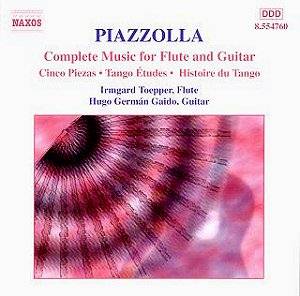
Like so many other 20th Century composers, once dismissed for writing music people might enjoy (see also my review of Nino Rota's Chamber Music) Piazzolla refused to follow fashion, basing as suited him, much of his music around the tango. He was Argentinean, born in 1921and had a diverse career ranging from jazz to cinema to the concert hall.
There are three works on this disc, each languid, light and lazily enchanting. Cinco Piezas for guitar is, in this performance, a work lasting some 19 minutes and while the rhythmic elements of the tango buried deep within any dance to this music would have to be very free. The Buenos Aires born guitarist Hugo Germán Gaido has a fluently understated musicality, and it is the subtle details such as his control over harmonics and stopped notes that reveals his mastery.
One might presume that 25 minutes of Tango Études for flute was stretching things, but the German flautist Irmgard Toepper captures the attention with her very forthright and confident playing, and with her atmospheric timbres. Perhaps inevitably, in their monophonic formality certain passages call to mind Bach partitas. Yet other sequences, perhaps with equal inevitability, summon images from Debussy.
The programme ends with the almost 22 minutes of Piazzolla's final word on the subject: Histoire du Tango, for flute and guitar, four movements charting the development of the form at 30 year intervals. The interplay between the two instruments, which is often sprightly and joyous, does make this the most accessible and interesting of the three works. Just try the infectious opening movement 'Bordel 1900', which develops into a memorable theme which you may find naggingly familiar yet frustratingly be unable to place. However, once again those hoping for anything in vaguely danceable tango form had better be very supple indeed. The more reflective and pastoral moments, especially the melancholy guitar passages remind me, of all things, of the one-time rock guitarist Anthony Phillips, who left Genesis after the band's second album (Trespass) in 1970, and who went on to make a series of mainly acoustic albums under the over all title of Private Parts and Pieces. Just listen to Café 1930 [4:15 - 4: 42], and if you are of a certain age and once fell victim to progressiverockfandom completedisographyitis you may recall that Philips made an album of duets - Private Parts And Pieces Part III: Antiques with Argentinean guitarist Enrique Berro Garcia. Yet the similarity extends to Philips overall style.
The barriers between musical genres are not as firm as once they were, such that these attractive works may not properly come under classical music at all. Some might find it on the edge of jazz, or folk, or even New Age. Given that the music has mutated from the tango's origins as an erotic dance in the brothels of Argentina a century ago, it might easily set the mood to many a romantic night. So yes, you may call it background music if you will, but it really must be something as obvious as the climate, because come the hot humid nights of early May this album suddenly came alive. When it is simply too hot and humid for bold European musical drama - music born of a cold climate - this proved ideal. Wait for a sultry summer night. Slip this in the CD player and catch the breeze.
Reviewer
Gary S. Dalkin

Collection: Gracie Fields
Sing As We Go
NIMBUS NI 2005 [62:29]
Purchase from: Crotchet Amazon UK
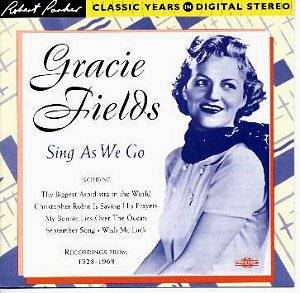
1. Sally
2. Oh sailor behave
3. Just one more chance
4. It isn't fair
5. Bargain hunter
6. Mary Rose
7. My lucky day
8. There's a lovely lake in London
9. Walter Walter lead me to the altar
10. Chapel in the moonlight
11. Sing as we go
12. It's a sin to tell a lie
13. I'll never say never again14. Pity the poor goldfish
15. In my little bottom drawer
16. Laugh at life
17. I took my harp to a party
18. Mockingbird went cuckoo
19. Fred Fanna
20. Stop and shop in the Co op shop
21. We've got to keep up with the Joneses
22. Have you forgotten so soon
23. Roll along prairie moon
24. Goody goody
25. Daisy daisy
26. Light in the window
Eee! It’s grand to hear our Gracie again – and in such wonderful sound too! Stereo sound from original mono 78s? Well imagine that! These clever folk nowadays can work miracles with all their hi-tech gadgetry and Gracie sounds just like she did in the old days when we heard her on the radio cheering us all up in the dark days of the 1930s depression and the war -- better in fact!
Born on 9th January 1898, Gracie Fields was an institution. Her irrepressible, sparkling personality endeared her to all in this country – and further afield - even during the war when she was vilified by the press for leaving the UK so as to avoid internment for her second husband, comic/dancer/director Monte Banks (Mario Bianchi) who was an Italian subject. In fact, Gracie spent a lot of her time entertaining the troops through the war years.
Gracie faced enough tragedy in her life: she fought against cancer, endured a frightful first marriage and lost Monte in 1950 when he died from a heart attack. She settled in Capri, with her third husband, Boris Alperovici, where she opened her famous bathing complex restaurant called La Canzone Del Mare (The Song of the Sea), that was frequented by the rich and famous. Gracie was created Dame of the British Empire by her old friend the Queen Mother on 20th February 1979. She died in the September of that year.
With John Loder in a scene from Queen of Hearts (1936)
Gracie, of course, made numerous films in the 1930s and 40s most famously, perhaps, Sally in Our Alley (1931), Sing As We Go (1934) and Holy Matrimony (1943).
Her larger than life, warm-hearted personality spilled over into her songs and you can ‘hear her smiling’ as she joyfully pushes hard on those top notes and adds her inimitable yodelling and other ‘Gracie’ mannerisms. She had a lovely and impressive wide-ranging voice. You only have to listen to the way she delivers that beautiful song, ‘Did I Remember’ to be moved almost to tears. But it was her comic songs that will be remembered: The Biggest Aspidistra in the World that became a danger to passing aircraft, or "we ran out of confetti and had nothing to throw; so we threw the Little Pudden Basin that belonged to Auntie Flo", or "I took my harp to a party – but nobody asked me to play". And of course there was the sentimental Sally and those wonderful rousing numbers that chased our blues away: Sing As We Go through the depression years and Wish Me Look (as you wave me goodbye) at the beginning of the War.
A bumper bundle of 31 golden memories, twelve of which come from stage performances circa. 1947 and 1968.
Admittedly Gracie is now really only remembered by a diminishing and ageing audience but for those of us (over the age of say 50) who do remember her, then of course the rating for this album could only be-

Reviewer
Ian Lace

Collection: Judy Garland
21 Hollywood Hits
NIMBUS NI 2004 [66:41]
Purchase from: Crotchet Amazon USA
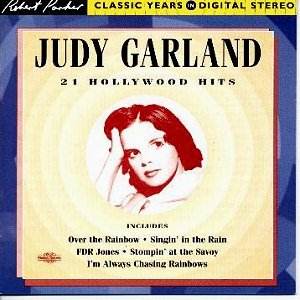
Over the rainbow.
Stompin' at the Savoy.
Swing Mr Charlie.
You made me love you.
You can't have everything.
All God's Chillun got rhythm.
In Between.
Figaro.
Oceans Apart.
Friendship.
I'm Nobody's Baby.Alone.
Singin' in the rain.
It's a great day for the Irish.
Minne from Trinidad.
Chin Up Cheerio Carry On!.
FDR Jones.
How About You?
Hoe Down.
On the Sunny Side of the Street.
I'm always chasing rainbows
This second release, by Nimbus, this month, of golden oldies brilliantly refurbished, from 78s, into very good quality modern digital stereo sound, is devoted to some 20 numbers by a young Judy Garland (1922-1969) in the late 1930s and early 1940s.
The recordings come from the Metro-Goldwyn-Mayer and from Decca. She signed with MGM in 1935 and with Decca in 1937. The two concurrent contracts allowed her to make soundtrack recordings at MGM and commercial ones at Decca, often of the same songs.
This collection includes many favourites such as ‘Over the Rainbow’ (The Wizard of Oz); ‘Swing, Mr Charlie’; ‘Friendship’; ‘On the Sunny Side of the Street’; (I Love New York in June) ‘How About You’; ‘You Can’t Have Everything’; (Dear Mr Gable) ‘You made Me Love You’ and ‘It’s a Great Day for the Irish’. Judy’s great sincerity shines through them all. One can only admire in wonderment, Judy’s vast expressive powers – so very apparent when you saw her on the screen. Listen, for instance to her singing ‘Chin Up, Cheerio, Carry On!’ – what pride and encouragement she must have given the troops when they heard this song in the dark days of 1941, and yet you can also hear a tinge of sorrow at the thought of their departure. Judy lived all her songs, she was a real dramatic singer in the literal sense of the word.
The packaging is excellent with informed notes by Lawrence Schulman and a full description of each song by Max O. Preeo, Editor of Show Music.
For Judy fans, heartily recommended
Reviewer
Ian Lace

Collection: British Light Music Discoveries.
Music by Sir Malcolm Arnold, Philip Lane, William Blezard, Eric Fenby, Raymond Warren, Adrian Cruft, Anthony Hedges, Paul Lewis and Arthur Butterworth
Royal Ballet Sinfonia conducted by Gavin Sutherland
ASV CD WHL 2126 [74:08]
Purchase from: Crotchet
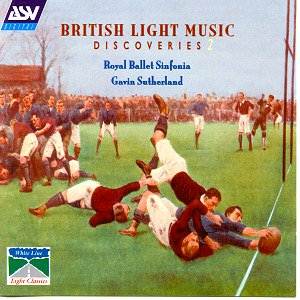
Discoveries is the operative word here, for this is an engaging collection of very little known, accessible and melodic little gems from composers who in the main have strong links with films and television.
Sir Malcolm Arnold’s contribution to the movies is well known. His Little Suite, which opens the concert, begins with a Prelude that wittily lampoons Elgarian/Waltonian ceremonial music. A hesitant, plaintive Siciliano follows, rather Ravel-like that becomes something of a lullaby with strains of the nursery tune, ‘Rock-a-bye Baby’. The suite ends raucously with a Rondo that seems to visit London’s Cockney East End.
William Blezard (b. 1921) worked at the Rank studios at Denham on films like Noel Coward’s The Astonished Heart but he is best known as accompanist to Joyce Grenfell and Marlene Dietrich, Max Wall and Honor Blackman. His lovely composition, The River is a real find. It dates from 1969 and was written following a visit to Australia. It pictures a couple meeting by a gently running stream that pervades virtually every bar of the score but how magically Blezard uses his orchestral palette. The couple seem to meet tentatively, the orchestral colours muted, with material mostly in the low woodwinds. Then passion overwhelms them, the instrumental colours lighten while the music intensifies, the waters seeming more tumultuous. The work ends serenely on harp and violins
Adrian Cruft’s (1921-87) Traditional Hornpipe Suite originally formed an accompaniment to a mime play, The Seafarers, which was presented by the Scottish Children’s Theatre and received a Royal Command performance at Balmoral in 1957.
The suite consists of six sparkling movements with the hornpipes in various guises emulating English and Scottish folk music.
Eric Fenby is best known as Delius’s amanuensis but he also wrote the music for Alfred Hitchcock’s Jamaica Inn that starred Charles Laughton. Rossini on Ilkla Moor, is, as the name implies, a very clever and amusing pastiche in the style of Rossini, as though the Italian composer might have composed the famous Yorkshire folk tune.
Raymond Warren’s (b. 1928) Wexford Bells is a most appealing pastiche with much humour. It is scored for a smallish orchestra; the size of what was then the BBC Northern Ireland Light Orchestra for which it was commissioned. The opening ‘Shepherd’s Dance’ is charming with high woodwinds playful over persistent snare drum; there is a Handelian elegance too. This movement together with the plaintive lullaby that follows is based on material from a 17th century Dublin lute book. ‘Christmas Jig’ is a joyful celebration with many familiar Irish cadences present; and the fourth movement ‘Wexford Bells’ with its chiming rhythms has celebratory tubular bell figures and laughing, chattering woodwinds.
Arthur Butterworth’s (b. 1923) The Path Across the Moors is vividly evocative of hikers plodding up steep, stony slopes (with ‘Mrs Ramsbottom’ puffing and panting in the rear?) There are also intimations of bleating sheep, thunder claps and winds. But all seems to be worth the glorious view from the peak. The work ends quietly as the walkers fade into the distance leaving the landscape empty and still.
Anthony Hedge’s (b.1931) An Ayrshire Serenade is a very vibrant and colourfully kaleidoscopic invention that takes the music on a longish journey, through many styles from its Scottish roots. Paul Lewis’s (b. 1943) English Overture is another puckish arrangement and assembly of well-known West Country folk tunes like ‘Uncle Tom Cobley’
The concert concludes with a work by Philip Lane well known to visitors of this site as a film score reconstructionist and producer etc. (He has produced this album). Philip’s beautifully harmonised and orchestrated Suite of Cotswold Dances opens with the ‘Wheatley Processional’ full of fun and joie de vivre. ‘Constant Billy’ is a lovely fragrant romance, full of nostalgic charm. ‘Brighton Camp’ is another charmer, nicely whimsical,
‘Jockie to the Fair’ is more boozy and rumbustious. ‘Ladies of Pleasure’ is all dreamy romantic pastels and the concluding ‘Princess Royal’ is a merry rustic dance.
The Royal Ballet Orchestra clearly enjoy themselves making these light music discoveries and the sound is excellently engineered. Recommended.
Reviewer
Ian Lace

DVD Music Review
Berlin Philharmonic Orchestra’s "Latin America Night" (Waldbühner, Berlin, 1998)
Conductor – Daniel Barenboim.
TDK mediactive [91 mins] EAN:545027000156.
Purchase from: Blackstar £22
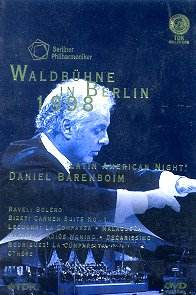
This is the first, and I am sure not the last DVD classical music video that we have had for review on Film Music on the Web.
It is a recording of an open-air concert in 1998, in a Berlin park attended, incredibly, by 20,000 people. The Berlin Philharmonic play, with great enthusiasm and to enthusiastic applause, a popular concert under the title, "Latin America Night".
The programme kicks off with a spirited performance of Ravel’s Bolero followed by Bizet’s Carmen Suite No.1. As the evening darkens there are short favourites including Ernesto Lecuona’s Malagueña; Horacio Salgán’s A Don Agustin Bardi; and Gerardo Matos Rodriguez’s La Cumparsita. Daniel Barenboim is the piano soloist and conducts, from the keyboard Astor Piazolla’s magnificent, romantic Adiós Nonino, which is something of a one-movement, 14-minute concerto with a ravishing melody. If you are not familiar with some of these titles, you will most probably know the music, much of which has been used in films down the years.
A colourful, highly enjoyable, undemanding concert. The DVD Digital 5.1sound is excellent, well defined and with wide perspectives and the pictures are first-class too.
I look forward to hearing more from TDK.
Reviewer
Ian Lace

Book Review
The Lord of the Rings By J.R.R. Tolkien
The Millenium Edition published in seven hardback volumes in special slipcase with accompanying CD of Tolkien reading excerpts.
Harper Collins ISBN 0 261 10393 8
Purchase from: Amazon UK
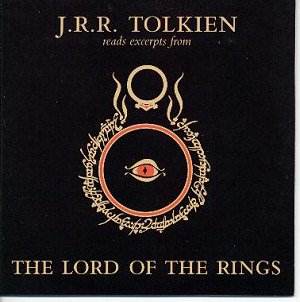
Arguably the book of the 20th century, The Lord of the Rings is now being filmed so here is a chance for all those who have read it and loved it - particularly all those undergraduates of the 1950s and 1960s, who regarded it as compulsory cult reading – and so many new readers, to reacquaint or acquaint themselves with this glorious epic story.
Chance to meet the Hobbits, Frodo, Bilbo Baggins, Merry Brandybuck and Pippin; to meet Gandalf the wizard, slimy Golum, the heroes Strider and Boromir; and Legolas, Aragorn, the Ents, Treebeard, the Riders of Rohan and all the epic’s other unforgettable characters.
Three Rings for the Elven-kings under the sky,
Seven for the Dwarf-lords in their halls of stone,
Nine for Mortal Men doomed to die,
One for the Dark Lord on his dark throne
In the land of Mordor where the Shadows lie,
One Ring to Rule them all, One Ring to find them,
One Ring to bring them all and in the darkness bind them
In the Land of Mordor where the Shadows lie.
The CD has great historical and literary interest for it comprises readings from The Lord of the Rings by its author J.R.R. Tolkien in 1952 before he had found a publisher to accept his masterpiece. Understandably then he does sound a little dispirited as he reads these excerpts - mainly verses. Without seeming to be uncharitable, because this is an immensely valuable recording, Tolkien does tend to gabble at times and his diction is not always clear, proving once again that authors are not always the best readers of their own works – that’s why the job is traditionally left to actors.
Harper Collins tell me that another edition of The Lord of the Rings is imminent in the Autumn, we will bring you news of that when it is published.
A rating for this well-loved work would be as insolent as it would be superfluous
Reviewer
Ian Lace

 |
| Discs
on these pages are offered for sale. There is also a page of search
engines from a selection of on-line retailers
here.
Please support this web-site by buying your discs here. Disclaimer: Every effort is made to make sales links to the correct disc but, in the end, you must take responsibility for checking that what you are purchasing is what you want. Some of these discs were not actually available for sale at the time of posting but a link has been made in anticipation of their forthcoming availablility. |
Return To Film Music on the Web
e-mail:
info@musicweb.uk.net